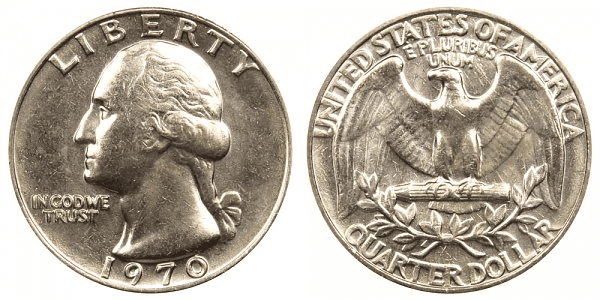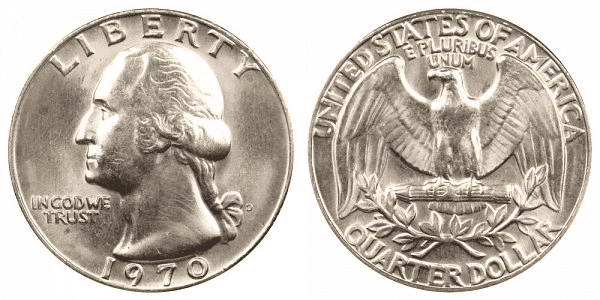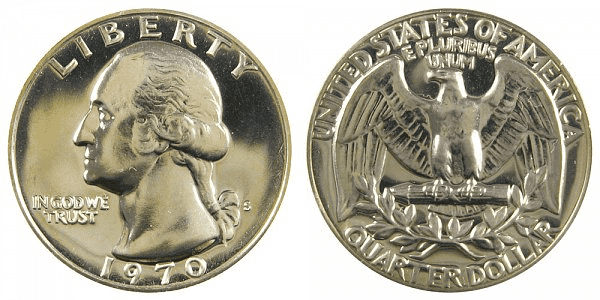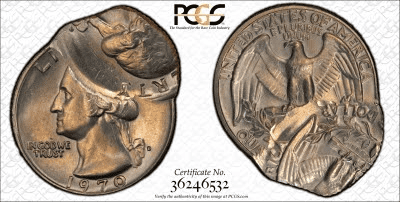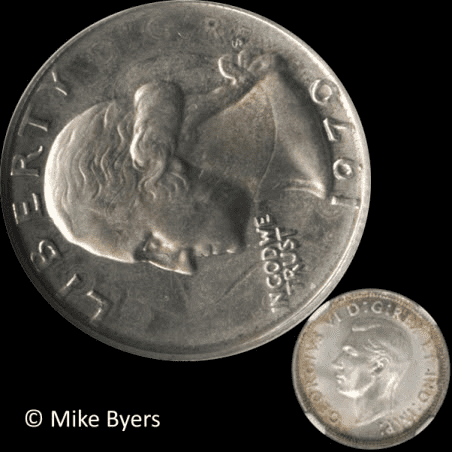Does A 1970 Quarter Have Silver?
Instead of the silver content of the older coins, Washington Quarters have a 91.67% copper core with an 8.33% nickel coating starting in 1968. The image of George Washington facing left on the coin’s obverse was created by John Flanagan using the bust of Jean-Antoine Houdon from 1786 as his model.
The word “LIBERTY” is engraved around the top of the coin and over Washington’s hair. The year “1970” is etched around the bottom of the George Washington bust that has been shortened.
To the left of Washington is the slogan of the nation: IN GOD WE TRUST.
The coin’s reverse has an Art Deco heraldic-styled eagle perched on a bundle of arrows. The arrows and the head of the eagle both point to the left. “United States of America” is printed all the way around the top of the coin, and two sprays of olive branches arranged in the shape of a U surround the base of the eagle.
Below it is the motto E PLURIBUS UNUM. On the coin’s base, the word “QUARTER DOLLAR” is printed. The edge of the 1970 Washington quarter is reeded.
The Vietnam War was in full swing in 1970. Millions of Americans took part in violent protests at home, and student strikes caused university campuses to close. At Kent State University in Ohio, National Guard members shot and killed four demonstrators.
1970 Quarter Varieties
1970 Quarter With No Mint Mark
Year: 1970
Face Value: $0.25
Composition: 91.67% Copper and 8.33% Nickel
Total Weight: 5.67g
Diameter: 24.3 mm
Thickness: 1.95 mm
Edge: Reeded
Minted in: Philadelphia
Quantity Minted: 136,420,000

photo source: www.usacoinbook.com
1970 D Quarter
Year: 1970
Face Value: $0.25
Composition: 91.67% Copper and 8.33% Nickel
Total Weight: 5.67g
Diameter: 24.3 mm
Thickness: 1.95 mm
Edge: Reeded
Minted in: Denver
Quantity Minted: 417,341,364

photo source: www.usacoinbook.com
1970 S Proof Quarter
Year: 1970
Face Value: $0.25
Composition: 91.67% Copper and 8.33% Nickel
Total Weight: 5.67g
Diameter: 24.3 mm
Thickness: 1.95 mm
Edge: Reeded
Minted in: San Francisco
Quantity Minted: 2,632,810

photo source: www.usacoinbook.com
Error Coins
Some of the strangest coins you will ever see can be error coins. When the coin blank isn’t fully inserted into the press, the coins come out of center. As a result, the design is pushed out of the center and part of the coin is left smooth. The value of a coin increases with the degree of off-centering.
A double strike and an off-center strike are combined in one exceptionally bizarre 1970-D quarter. This coin, which was graded MS64 and was “Double Struck – Second Strike 70% Off-Center,” sold for $1,020 in 2021.

photo source: www.gainesvillecoins.com
Other odd 1970 error quarters include the 1970-D struck on a Lincoln cent planchet, which sold for $1,260; the 1970-D struck on a Jefferson nickel planchet, which cost $216; the 1970-D quarter that lacks the copper-nickel cladding on the obverse, which cost $540; and the 1970-S proof quarter, which cost $1,175 and was double struck in the coin press collar.
When this quarter was struck, the obverse die was a little loose and turned a touch before the second strike.
How Can You Tell If A 1970 Quarter Is Rare?
The 1970-S quarter struck on an 80% silver 1941 Canadian quarter is the most well-known and expensive 1970 error quarter. This rare coin has a whooping $35,000 value according to appraisal
One of the best coin grading services in the world, the Numismatic Guaranty Corporation (NGC), assigned this one-of-a-kind coin a PF65 grade. Mike Byers, an expert in mistake coins and author, is the owner. He described the coin as “one of the most fascinating and intriguing proof mint errors ever discovered.”
This error occurred when, somehow, the Washington Quarter design was struck onto metal used for the 80% silver 1941 Canadian Quarter (some of the details of the previous coin can still be seen through the over strike). It’s not known quite how this happened, but it’s certainly one interesting mix-up at the San Francisco mint.

photo source: www.gainesvillecoins.com
Other Striking Errors
There is a second infamous overstrike of a 1970-S quarter, also on a Canadian coin. The quarter in question was minted on top of a silver Canadian George V quarter. Sadly, Washington’s neck hides the date, but the other details are clearly visible. In August 2020, this one-of-a-kind proof mistake coin, which NGC graded PF64, sold for $7,800.
The 1970-S quarter produced on a Philippines 25 centavo currency is another rare 1970 mistake coin. This coin has what Heritage Auctions refers to as a “brassy” appearance, making it one of the simpler proof mistake coins to identify. In 2010, it sold for $4,600 and was rated a proof PR64.
In general, it’s pretty easy to tell if you have a rare coin on your hands if you know what the coin should look like, that is, as the rarest errors are those that are most obvious, such as the examples above as they represent the most dynamic deviation from the original coin.
How Much Is A 1970 Quarter Worth Today?
A 1970 quarter’s low $0.052 melt value shows that any value (beyond the face value) attached to this money comes from factors like condition, defects, and provenance. Due to the absence of precious metal, this coin has no melt value. The primary value of these coins, barring rarities, is decided by their condition, with the exception of MS-grade coins, which are only worth their face value because they are still in circulation.
As mentioned, outside of rare errors these coins have little more than their face value unless they are in incredible condition. Uncirculated proof coins are worth about $4.52, while MS65 Grade 1971-P and 1971-D coins are worth up to $7.88 and $5.70 respectively.
How Does The Grading System Work?
The Sheldon Scale is used by numismatists to provide a numerical value to coins. The Sheldon Scale goes from poor (P-1) to perfect mint state (P-1) (MS-70). Coins were originally evaluated using words to reflect their condition (Good, Fair, Excellent, Etc.). Unfortunately, coin collectors and dealers had different ideas about what each of these terms represent.
Professional numismatists joined together in the 1970s and established CoinGrading standards. These numismatists now assign grades at key places on the seventy-point scale, using the most regularly utilized numeric points in conjunction with the original adjective grade. The following are the most common coin grades:
-
-
- (P-1) Poor – Indistinguishable and probably damaged; if used, must have a date and mintmark; otherwise, rather battered.
- (FR-2) Fair – Nearly smooth, but without the damage that a coin graded Poor often possesses. The coin must have enough detail to be identified.
- (G-4) Fair – Inscriptions have merged into the rims in some areas, and important elements have been mostly erased.
- (VG-8) Very Good- A little weathered, but all of the primary design elements are visible, albeit faintly. There is little if any, central detail left.
- (F-12) Good – The item is very worn, yet the wear is even, and the overall design details stand out clearly. Rims are almost completely isolated from the field.
- (VF-20) Very Fine – Moderately weathered, with some finer features still visible. The motto or all letters of LIBERTY are readable. Both sides of the coin have entire rims that are separated from the field.
- (EF-40) Extremely Fine – Gently used; all gadgets are visible, and the most important ones are bold. The finer details are bold and clear, however, light wear may be seen.
- (AU-50) Uncirculated – Slight evidence of wear on the coin’s design’s high points; may have contact marks; eye appeal should be adequate.
- (AU-58) Uncirculated Choice – Slight traces of wear, no severe contact marks, almost full mint shine, and great eye appeal.
- (MS-60) Mint State Basal – Strictly uncirculated; no indication of wear on the coin’s highest points, but an unsightly coin with reduced luster, visible contact marks, hairlines, and other flaws.
- (MS-63) Mint State Acceptable – Uncirculated, but with contact scratches and nicks, little reduced shine, but otherwise appealing appearance. The strike is weak to average.
- (MS-65) Mint State Choice – Uncirculated with great mint shine, very little contact blemishes, and exceptional eye appeal. The strike is unusually severe.
- (MS-68) Mint State Premium Quality – Uncirculated with superb luster, no obvious contact marks to the naked eye, and exceptional eye appeal. The strike is quick and appealing.
- (MS-69) Almost Perfect Mint State – Uncirculated with perfect brilliance, a sharp and appealing strike, and extremely good eye appeal. A near-perfect coin with minor imperfections in the planchet, strike, and contact markings (seen only under 8x magnification).
- (MS-70) Mint State Perfect – Under 8x magnification, there are no tiny imperfections discernible; the strike is crisp, and the coin is perfectly centered on a beautiful planchet. Rarely seen on a coin, this coin is bright and whole, with original luster and exceptional eye appeal.
-
Where To Buy Or Sell 1970 Quarters?
If you have a 1970 quarter in your collection, it could be worthwhile to examine it carefully to check for any flaws or distinctive traits before you consider selling. There are various 1970 quarters to watch out for, such as those listed above, though these are exceptionally rare.
Regular 1970 quarters can be bought or sold for a few dollars on websites like Etsy and eBay. You can post an image in a forum for coin collectors to ask for help if you’re unsure but think you might have something unusual.
Dealing solely with reliable, specialized sellers like Heritage Auctions. will help you avoid fraud while buying and selling rare 1970 quarters.
FAQs
Are all 1970 quarters valuable?
No, not all 1970 Quarters are valuable as the coin itself only has an intrinsic metal value of little more than its face value. The valuable 1970 quarters are those in excellent condition as well as those with the errors mentioned in the article.
Do all 1970 quarters have an error?
No, not all 1970 quarters have an error. There are also no reported national errors seen in this coin meaning the errors that you may come across are on a coin-by-coin basis.
Are 1970 spy coins real?
While an exciting idea and definitely seen in modern times and reproductions, there’s no evidence showing 1970 Quarters being used as spy coins.
Are there 1970 quarters worth $35,000?
Yes, the 1970-S quarter struck on an 80% silver 1941 Canadian quarter has been valued at $35,000.

